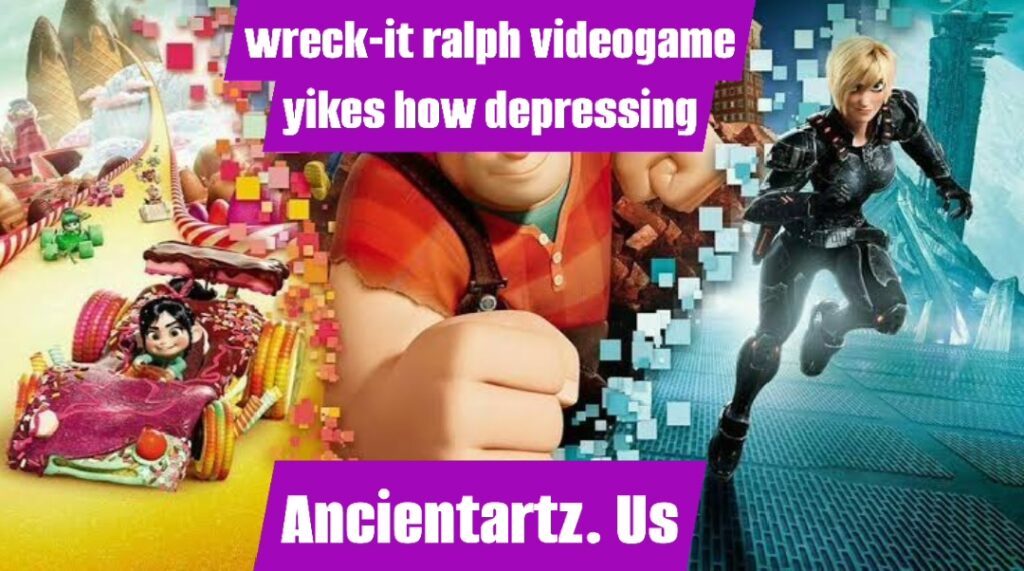Introduction
The world of video games is often celebrated for its fun, excitement, and the sense of freedom it offers to players. Whether it’s engaging in epic battles, solving challenging puzzles, or exploring vast new worlds, gaming has always provided an escape from reality. However, there’s a certain side of video games that often gets overlooked—the emotional toll they can take on players. While many games aim to offer a sense of achievement and joy, others inadvertently strike a chord with more melancholic themes. One game that embodies this darker side is the Wreck-It Ralph video game, inspired by the 2012 animated movie of the same name.
At first glance, Wreck-it ralph videogame yikes how depressing might seem like a light-hearted, fun game that fits well with its movie’s family-friendly tone. However, as players delve deeper into the game’s storyline and mechanics, a disturbing undercurrent emerges, making it feel strangely depressing. The game captures the plight of Ralph, the movie’s central character, who is stuck in the role of a villain in his arcade game, Fix-It Felix Jr.. His desire for recognition, acceptance, and a sense of belonging sets the stage for a larger exploration of existential themes such as loneliness, self-worth, and the search for purpose. These elements are embedded in the gameplay in such a way that players can’t help but reflect on their own feelings of isolation and their struggles with societal expectations.
The more you play Wreck-it ralph videogame yikes how depressing, the more you realize how much it mirrors the emotional struggles that many people face in real life. The game, despite its bright colors and nostalgic pixelated graphics, presents a somber look at the life of a video game character who is cast as a villain, simply because that is his role. He is perpetually doomed to destroy buildings while the heroic Fix-It Felix is celebrated for fixing them. This deeply ingrained unfairness forms the crux of the game’s melancholic tone. Moreover, as players navigate through the game, they also encounter a series of other characters that are, in their own ways, trapped by their roles and expectations within their own respective games. These characters, much like Ralph, long for change and freedom, and yet they remain constrained by the very nature of the arcade world in which they live.
In this article, we will delve into the various reasons why Wreck-It Ralph, as a video game, can be seen as unexpectedly depressing. From its portrayal of Ralph’s internal struggle to the depiction of other characters’ lives, we will explore how these elements contribute to the game’s overall emotional impact. While Wreck-It Ralph might not have been designed to evoke sadness, its themes and underlying messages resonate on a deeper level, raising questions about identity, societal roles, and the pursuit of happiness.
Ralph’s Struggle with Self-Worth: The Villain’s Perspective
One of the primary reasons wreck-it ralph videogame yikes how depressing is so emotionally impactful is due to the protagonist’s struggle with self-worth. Ralph is a classic “bad guy” in his game, Fix-It Felix Jr., a role that is as limiting as it is solitary. His character is essentially reduced to a stereotype: the giant, destructive villain who ruins everything for the hero, Fix-It Felix. In this sense, Ralph’s existence is defined by his job in the game world. He is expected to wreck things, to be the antagonist, and is never given the chance to be more than that. The game does not offer Ralph a redemption arc or a chance to escape his predetermined role. He is trapped in a never-ending loop of destruction and rejection.
As Ralph yearns for acceptance and recognition from the other characters in his game, he faces harsh rejection. He is excluded from the parties, ignored by his fellow game characters, and belittled by the very people he is meant to interact with. The game’s story mirrors a common human experience—the feeling of being stuck in a dead-end job or an unfulfilling life, where personal growth seems impossible due to external expectations or societal pressures. Ralph’s internal monologue throughout the game showcases his frustrations and his desire for something more. His quest to be a hero, to break free from his villainous role, is not just about his character arc within the game but also about the broader human longing for a sense of purpose beyond the roles society has carved out for us.
This narrative invites players to reflect on their own lives, particularly on how much they may feel defined by external labels or the roles they are expected to play in society. Ralph’s journey resonates because many individuals find themselves in similar situations: trying to break free from labels and find a space where they can be accepted for who they truly are, rather than who others expect them to be.
The Unfairness of the Game World: A Metaphor for Life’s Inequities
The depiction of Fix-It Felix Jr. and its rigid structure serves as a metaphor for the broader inequities that exist in life. In the game world, Ralph’s role is to destroy buildings, while Fix-It Felix is celebrated for repairing them. This dynamic highlights a sense of injustice that is impossible to escape. Ralph cannot change his role, and no matter how hard he tries, he remains stuck as the villain. Even when he tries to prove himself, he faces rejection from the people who inhabit his world. This can be seen as a commentary on how people often feel trapped in situations where they cannot escape their assigned roles, whether it’s in their personal, professional, or social lives.
The game’s design subtly critiques the unfairness of the world. Wreck-it ralph videogame yikes how depressing frustration is palpable as he watches Felix receive praise for actions he himself performs, albeit in the opposite direction. There is no recognition for Ralph’s contributions, and his character is perpetually undervalued. This reflects how individuals who might work hard, but are overlooked or underappreciated, can feel defeated. Ralph’s attempt to find a way out of his cycle of destruction and rejection becomes symbolic of anyone who seeks to break free from a life that feels unjust, unfair, or limiting.
The Deeper Meaning of Ralph’s Desire to Be a Hero
Wreck-it ralph videogame yikes how depressing desire to be a hero is not just about seeking fame or accolades—it’s about wanting to be seen as valuable, worthy, and important. Throughout the game, he yearns for a sense of purpose, but not for the superficial reasons that might initially seem obvious. His desire stems from the belief that if he were a hero, people would respect him, and he would feel like he mattered. His quest is not simply about being “good” but about being seen as someone who has worth beyond his destructive actions. The game explores this theme deeply, questioning why people often feel like they have to live up to certain ideals or expectations in order to gain respect and recognition.
In a world where success is often tied to specific achievements or roles, Ralph’s story mirrors the struggles of those who feel they are not living up to society’s standards. Whether it’s due to career choices, social standing, or personal relationships, many individuals can relate to the feeling of being overlooked or disregarded for who they are, not just what they do. Ralph’s internal journey to redefine himself and become a hero is a universal theme—an exploration of the human desire to be valued for more than just the role we are cast in.
The Other Characters’ Struggles: The Emotional Burden of Arcade Life
Ralph is not the only character trapped in the repetitive cycle of arcade life. The other characters in the game world also experience their own limitations and struggles. Fix-It Felix Jr., for instance, is celebrated as the hero of his game, but his sense of self-worth is tied entirely to his ability to fix things. His entire identity is defined by his role in the game, and while he is celebrated, this praise doesn’t necessarily reflect any deeper sense of fulfillment. Similarly, characters like Vanellope von Schweetz in Sugar Rush are also trying to escape their predefined roles, with the added layer of being marginalized or rejected by society.
The struggles of these characters highlight how deeply ingrained societal expectations can trap individuals in cycles of self-doubt and frustration. Each character’s desire for change, whether it’s Ralph’s quest to be a hero or Vanellope’s battle to be accepted as a racer, reflects a broader message about the limitations that are often imposed on people by external forces. These struggles add depth to the emotional complexity of the game, revealing how its characters are more than just pixels and algorithms—they are representations of real-life emotional conflicts.
Conclusion
In conclusion, the wreck-it ralph videogame yikes how depressing, while often perceived as a lighthearted and fun arcade adventure, is actually a profound exploration of the emotional complexities faced by video game characters who are bound by their roles. Ralph’s journey from villain to hero serves as a metaphor for the human desire for recognition, acceptance, and a sense of purpose. The game highlights the inherent unfairness of a world where individuals are constrained by external expectations and labels. The struggles of Ralph and the other characters reflect the real emotional challenges many individuals face when trying to break free from societal norms and find fulfillment on their own terms.
While the game’s bright colors and playful tone may initially mask its deeper emotional themes, its narrative speaks to universal feelings of loneliness, isolation, and the search for self-worth. The game reminds players that no matter how much we may seem to be living in a world of preordained roles, there is always room for change, growth, and the possibility of finding new purpose. Wreck-It Ralph may be a video game, but it is also an introspective exploration of identity, self-worth, and the importance of being seen as more than just the roles that are assigned to us.
FAQs
Q1: Is the Wreck-It Ralph video game appropriate for all ages?
Yes, the Wreck-It Ralph video game is designed to be family-friendly and is appropriate for players of all ages. However, the themes explored in the game, such as loneliness and the desire for self-worth, might resonate more with older players who can relate to these emotions.
Q2: How does the game address Ralph’s desire for recognition?
The game explores Ralph’s internal struggle to gain recognition and respect from his fellow characters. Throughout the game, he tries to prove that he is more than just a villain by embarking on quests to become a hero, highlighting his deep yearning for validation.
Q3: What are the main emotional themes of the Wreck-It Ralph video game?
The main emotional themes of the game include loneliness, self-worth, identity, and the desire for acceptance. Ralph’s struggle to break free from his role as the villain and be seen as valuable highlights the broader human desire for purpose and recognition.
Q4: Does the Wreck-It Ralph game provide any solutions to the struggles it presents?
While the game doesn’t necessarily provide clear-cut solutions, it encourages players to reflect on the idea that change is possible, and that one can redefine themselves regardless of the roles they are assigned.
Q5: Why does the Wreck-It Ralph video game feel depressing at times?
The game’s exploration of Ralph’s feelings of isolation, rejection, and his struggle to escape his predetermined role as the villain gives it an underlying emotional weight. These themes, coupled with the portrayal of other characters trapped in similar situations, create a melancholy tone throughout the game.
Also Read This: Wreck-It Ralph Video Game: Yikes, How Depressing!



